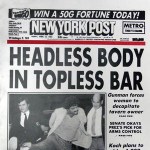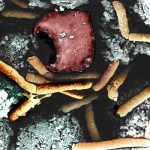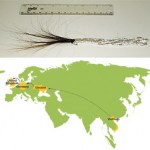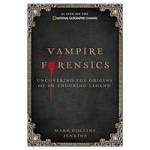forensics
Imagine the killer from the infamous "Headless Man Found in Topless Bar" murder was convicted using a photograph of the face of the victim, with reliability rivaling that of DNA analysis. Impossible?
With a skull found, how can we determine to whom it belonged?
A research group at the University of Granada has developed a new method that merges facial photographs with 3D images of a skull called craniofacial superimposition that could revolutionize forensic analysis.
How did they do it?
Identifying remains using photographs or even paintings has been used since the 19th century. This group…
Color-enhanced scanning electron micrograph shows splenic tissue from a monkey with inhalational anthrax; featured are rod-shaped bacilli (yellow) and an erythrocyte (red)
Credit: Arthur Friedlander
A university professor has allegedly mailed anthrax to the Pakistani prime minister's office in October, accoding to today's The New York Times. Could this be the beginning of a new anthrax scare? Is history repeating itself?
If true, any individual considering such "attacks" can no longer assume that their weapons are untraceable, as shown by the anthrax scare in 2001.
Below is an excerpt…
Wolfram Meier-Augenstein
Tragic Trajectory Forensic researchers used this 14-cm lock of hair to map a dead man's route to the U.K.
Measuring isotopes has come a long way. Recent reports describe an emerging field of environmental forensics. Where did those illegal drugs come from? Is that $1,000 bottle of scotch the real deal?
According to Chemical & Engineering News:
An analytical chemist at James Hutton Institute, in Dundee, Scotland, Meier-Augenstein has pioneered a way to help determine where unidentified victims like this one lived or traveled. To do so, he measures the stable…
NEW York City in the 1920s and '30s was a hotbed of criminal activity. Prohibition laws banning the production, sale and distribution of alcohol had been introduced, but instead of reducing crime, they had the opposite effect. Gangsters organized themselves and seized control of the alcohol distribution racket, smuggling first cheap rum from the Caribbean, then French champagne and English gin, into the country. Speakeasies sprang up in every neighbourhood, and numbered more than 100,000 by 1925. When prohibition was abolished in 1933, the gangsters took to other activities, such as drug…
tags: Every Pollen Grain has a Story, pollen, microscopy, forensics, pollen signature, pollen fingerprint, science, Bosnian war crimes, pollinology, Jonathan Drori, TEDTalks, streaming video
Pollen goes unnoticed by most of us, except when hay fever strikes. But microscopes reveal it comes in stunning colors and shapes -- and travels remarkably well. Jonathan Drori gives an up-close glimpse of these fascinating flecks of plant courtship.
TEDTalks is a daily video podcast of the best talks and performances from the TED Conference, where the world's leading thinkers and doers give the talk of…
Cordyceps in glass, by glass artist Wesley Fleming -- a strange depiction of a rather horrid business. For more, do go to the source, the lovely Myrmecos Blog, which is all about bugs.
Now, the best of the week's gleanings. I'm going to categorize them from here out, and at least try to keep them from being from completely all over everywhere about everything.
Mind, brain, and body (including those gene things)
While reading Wolpert's review of Greenberg's book about depression (he didn't much like it), I found that the Guardian has a particularly rich trove of writings and resources on…
We all know that as we type on our keyboards or click our mice, we leave behind fingerprints that could be used to deduce our identities. But these prints aren't the only remnants of our presence. Bacteria from our skins also linger on the things we touch and they could act as a sort of living fingerprint.
The thriving community of bacteria and other microscopic passengers on our skin has many traits of interest to a forensic scientist. For a start, they are remarkably personal in their membership and stable over time. Just 13% of the bacteria on my palm also live on yours, and even…
After a brief insurrection by their blue collar offspring, zombies, vampires have once more regained their prominence as the monster supreme, leaping out at us from every bookshelf, cinema screen and TV set. What better time then for Mark Jenkins to unleash his accomplished study of the bloodsucker legend, Vampire Forensics.
Published through National Geographic Books and accompanied by a television documentary, Vampire Forensics delves into the long history of the vampire, one which began millennia before a certain Bram Stoker set pen to parchment. Drawing upon the latest research in…
I've just started my book tour for The Poisoner's Handbook and people seem to be wondering why I (a friendly mother-of-two) am so fascinated by poisons. I admit to a fascination with murder mysteries (count on me later in this blog to write about Agatha Christie). I share my affection for forensic dramas on television. I talk about the thrill of discovering two forgotten and quite heroic forensic scientists from jazz-age New York.
And then I confess that I love chemistry - the most beautiful, the most fundamental, and on occasion the most sinister of all sciences - and…
On Tuesday, Feb. 23, National Geographic Explorer will be devoting an episode to "Vampire Forensics." You can preview a brief clip below the fold, but I'll warn you now: it's not CSI. It's more scientific ("unfortunately this evidence is inconclusive" LOL) and less sexy (inexplicably, Emily Proctor is nowhere to be seen). Overall, the feeling I got from the clip was sort of "Wow, we're National Geographic Explorer, that's pretty great, but we really wish we were sexy, like CSI. Does this sinister music help?"
In conjunction with the Explorer episode, National Geographic is releasing a book…
My new book - The Poisoner's Handbook - will be published next month (February 18). But it's already having this effect on my life: my husband has developed a nervous habit of moving his coffee cup out of my reach. When the Wall Street Journal published an excerpt of the book (see link below) I promptly received the following e-mail: "Read the wonderful weekend section front in the Journal. But the coffee my wife just handed me tastes a little odd."Â When the invitation was sent out for my book launch party, it read: "We promise that the beer, wine, and snacks will be completely…
"How We Decide" author Jonah Lehrer, fresh from a book tour of the UK, offers what he calls a "spluttering answer" (it's really quite lucid) to a question he says he's getting a lot these days: What decision-making errors were involved in our current financial meltdown??
The short version of his answer -- well worth reading in its entirety -- is that we (and big investment outfits particularlyl) succumbed to an abhorrence of uncertainty.
We hate not knowing, and this often leads us to neglect relevant information that might undermine the certainty of our conclusions. I think some of the…
There are a lot of stories bouncing around about a toy in Australia, Bindeez, which are apparently little beads that adhere to one another when you wet them. There are a ton of news sources getting very confused, but Reuters seems to have gotten it: they are contaminated with 1,4-butanediol, which your body metabolizes into GHB (a banned so-called "date rape drug.")
Humans evolved in the presence of ethanol - beverage ethanol is recent, evolutionarily speaking, but much of life creates a little bit of ethanol. It'd be much more toxic than it is if we didn't have a set of enzymes to deal with…



